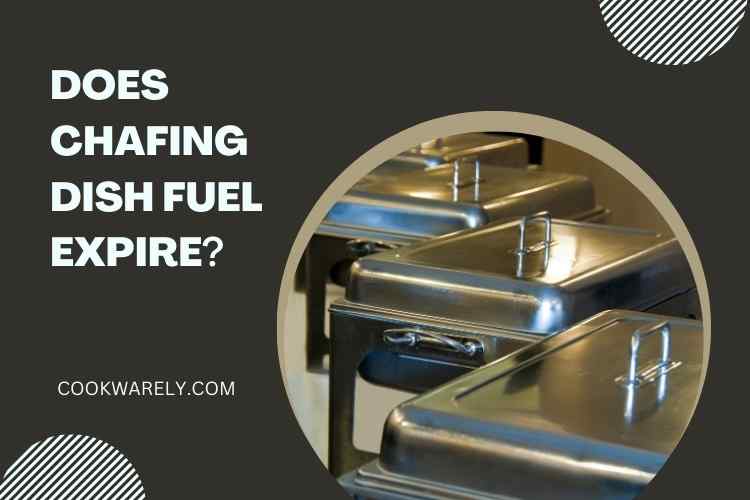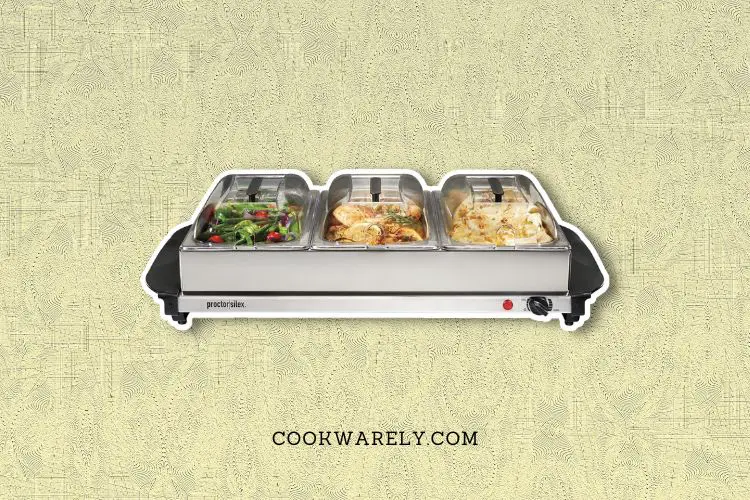Does Chafing Dish Fuel Expire?
Chafing dishes are a popular choice for catering and events, providing a convenient and portable way to keep food warm while it is served. One important aspect of using a chafing dish is ensuring that it is fueled properly, as the fuel keeps the food warm.
But with so many different types of fuel available, it’s natural to wonder: does chafing dish fuel expire?
Yes, chafing dish fuel can expire. The shelf life of chafing dish fuel depends on the fuel type and storage conditions. However, if the fuel is exposed to heat or moisture, it can expire sooner. It is important to check the package’s expiration date and store the fuel properly to ensure it is safe.
If you are interested in checking the best chafing dish fuel, you can find them here.
In this article, we will explore the different types of chafing dish fuel, how long they last, and whether or not they expire.

Does Chafing Dish Fuel Expire?
Does sterno expire? Chafing dish fuel is used to heat chafing dishes, which are commonly used to keep food warm during buffets and other events. But like any fuel, chafing dish fuel can expire.
There are different factors to consider in the chafing dish fuel:
Types of Chafing Dish Fuel
There are several types of fuel that can be used in a chafing dish, including gel fuel, ethanol fuel, and canned heat.
- Gel fuel is popular because it is easy to use and provides consistent heat for several hours.
- Ethanol fuel is another option, but it can be more expensive and requires a little more setup as it must be poured into a burner.
- Canned heat, also known as Sterno, is a solid fuel placed under the chafing dish and provides heat for several hours.
Shelf Life of Chafing Dish Fuel
The shelf life of chafing dish fuel will depend on the type of fuel being used. Gel fuel has a shelf life of around two years, while ethanol fuel can last up to five years if stored properly.
The canned heat has a shelf life of around three years, but it can last longer if stored in a cool, dry place.
Check out the Gas One Chafing Fuel on Amazon.
How Long Do Sternos Last?
Sterno, a brand of canned heat commonly used for chafing dishes and other food-warming applications, typically has a burn time ranging from 1 to 2.5 hours, depending on the size of the Sterno canister.
So, how long does Sterno last? A standard 7-ounce Sterno canister, when ignited, typically provides a steady flame for approximately 2.5 hours. In contrast, the smaller 3-ounce Sterno canister is designed to burn for approximately 1 hour under normal operating conditions.
These burn times are approximate and can be influenced by factors such as the ambient temperature, wind conditions, and the degree to which the Sterno burner is adjusted.
Users are advised to carefully monitor the Sterno flame and, when necessary, adjust the lid of the Sterno canister to regulate heat output.
It’s important to note that Sterno fuel is primarily used for temporary food warming during events, catering, or outdoor activities.
Therefore, users should plan accordingly and have an adequate supply of Sterno cans on hand to ensure uninterrupted service when needed.
Proper handling and storage of Sterno fuel are also recommended to maintain its effectiveness and safety.
Factors That Affect the Shelf Life of Chafing Dish Fuel
There are several factors that can affect the shelf life of chafing dish fuel, including storage conditions, the type of fuel being used, and the age of the fuel.
Proper storage is crucial for maintaining the shelf life of chafing dish fuel. Gel fuel and ethanol fuel should be stored in a cool, dry place to prevent them from breaking down or evaporating.
Canned heat should also be stored in a cool, dry place, but it should also be kept away from direct sunlight as it can cause the fuel to become unstable.
Signs That Chafing Dish Fuel Has Expired
There are a few signs that chafing dish fuel may have expired, including a noticeable change in the consistency or appearance of the fuel, a decrease in the fuel’s ability to burn, or an unusual smell when the fuel is burning.
If you notice any of these signs, it is best to dispose of the expired fuel and use new, fresh fuel to ensure that your chafing dish is functioning properly.
Check out the 7Penn Chafing Fuel on Amazon.
How to Properly Dispose of Expired Chafing Dish Fuel?
It is important to properly dispose of expired chafing dish fuel to prevent accidents and ensure the safety of those using the fuel.
Gel fuel can be poured into a metal container and disposed of in the trash, while ethanol fuel can be poured into a container and disposed of in the same way.
Canned heat should be placed in a metal container and disposed of in the trash, as it can become unstable if it is not properly disposed of.
Final Thoughts
Chafing dish fuel does expire, and paying attention to the fuel’s shelf life is important. Proper storage and disposal of expired fuel will help ensure the safety and effectiveness of your chafing dish.
By following these guidelines, you can ensure that your chafing dish is fueled properly and ready to keep your food warm and delicious at your next event.
FAQs
Does Chafing Fuel Expire?
Chafing fuel typically does not have a strict expiration date but can degrade in quality over time, affecting performance and safety. Proper storage and inspection of the fuel canisters are essential to ensure its effectiveness.
How Long Does Chafing Dish Fuel Last?
The shelf life of chafing dish fuel depends on the fuel type and storage conditions. Canned heat fuel, a common type of chafing dish fuel, has a shelf life of 5-10 years if stored in a cool, dry place. However, if the fuel is exposed to heat or moisture, it can expire sooner.
How Do You Store Chafing Fuel?
To store chafing fuel, keep it in a cool, dry place away from heat sources and flames. It is important to keep the container sealed when not in use to prevent evaporation.
Make sure to follow all safety instructions and keep the fuel out of reach of children and pets.
Does Sterno Dry Out?
Yes, Sterno does dry out over time. It is a type of chafing fuel made from denatured alcohol, which can evaporate if the container is left open or the seal is not tight.
To extend your Sterno’s life, keep it sealed when not in use and store it in a cool, dry place away from heat sources.
How Long Will a Can of Sterno Burn?
A can of Sterno will burn for approximately 2 hours when used in a chafing dish. The burn time may vary depending on the size of the can and the temperature of the surrounding environment.
To maximize the burn time of your Sterno, make sure to use it in a well-ventilated area and follow all safety instructions.
How Long Does a Sterno Last?
A Sterno typically lasts around 1 to 2.5 hours, depending on the can’s size and usage.
Do Sternos Expire?
Sternos don’t have strict expiration dates, but their quality may degrade over time, affecting performance.
Do Sterno Cans Expire?
Sterno cans generally don’t have expiration dates, but proper storage is crucial for maintaining quality.
How Long Does Chafing Fuel Last?
Chafing fuel’s burn time varies; Sterno lasts about 1-2.5 hours, depending on the can size.
Do Sternos Go Bad?
Sterno can deteriorate over time, impacting its performance, but it doesn’t “go bad” like perishable foods.
How Long Do Chafing Burners Last?
Chafing burners can last for hours, and their duration depends on factors like size and fuel type.
How Long Do Sterno Cans Last?
Sterno cans can last indefinitely if stored properly, but their effectiveness may decrease over time.
How Long Does a Can of Sterno Last?
A can of Sterno typically lasts around 1 to 2.5 hours, depending on its size and use.
How to Dispose of Chafing Fuel?
Dispose of chafing fuel by allowing it to burn out safely, letting it cool, and then sealing the empty can for disposal in accordance with local regulations for hazardous waste.
Do Sterno Cans Go Bad
Sterno cans can go bad if they are past their expiration date or have been improperly stored. It’s essential to check the expiration date and follow storage instructions.
How to Dispose of Chafing Dish Fuel
Dispose of chafing dish fuel by allowing it to cool completely, then seal it in its original container and check local regulations for proper disposal methods, which may vary by location.
Does Sterno Fuel Expire
Yes, Sterno fuel can expire. Check the expiration date on the canister to ensure it’s still safe and effective for use.
Fuel for Chafing Dish
Chafing dish fuel is typically available in gel or liquid form and is used to keep food warm during catering, buffet, or event service.
How Long Does a Sterno Can Burn
The burn time of a Sterno can varies based on its size and type, but it can typically burn for 2 to 6 hours, depending on the specific product.
Sterno Shelf Life
The shelf life of Sterno fuel varies depending on the type and brand, but it’s usually several years if stored in a cool, dry place and kept sealed. Always check the expiration date before use.






